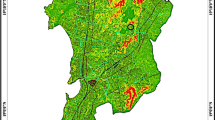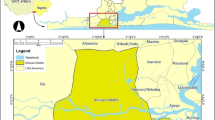Abstract
Gaya is the second largest city of South Bihar in India along the Falgu River, which has a historical significance. In order to meet the needs of present and future generations in terms of social, economic, and environmental aspects, the existing and present trend of urbanization of the city must be studied. Urbanization and rapid modification create considerable impacts on the land surface temperature (LST) of the Gaya district. The extensive rise of the LST creates urban heat island (UHI) effects in the cities. This study examined the effect of UHI by analyzing the LST and Land Use and Land Cover (LULC) of the Gaya district. The present study has been performed using OLI/TIRS data of Landsat 8 satellite. This study, further, focuses on the relationship between LST and two land surface indices, i.e., soil-adjusted vegetation index (SAVI) and the normalized difference built-up index (NDBI). The results of the study showed that the LST has a positive correlation with NDBI while a negative correlation with SAVI. This LST and NDBI relationship suggest that the built-up land can strengthen the effect of UHI, and the relationship between LST and SAVI suggests that the green land can weaken the effect on UHI. The study also revealed that this correlation has variation according to the availability of LST in the area. This type of study can be very useful for urban planners to cater the needs of any city planning. It also helps in the assessment of the health of the developing cities by assessing the urban expansion and their relationships with LST.












Similar content being viewed by others
References
Agnihotri AK (2018) Impact of green spaces on the urban microclimate through Landsat 8 and TIRS data, in Varanasi, India. Int J Environ Sustain 7(2)
Aithal BH, Chandan MC, Nimish G (2019) Assessing land surface temperature and land use change through spatio-temporal analysis: a case study of select major cities of India. Arabian J Geosci 12(11):367
Archer RW (1994) Urban land consolidation for metropolitan Jakarta expansion, 1990–2010. Habitat Int. 18(4):37–52
As-syakur A, Adnyana I, Arthana IW, Nuarsa IW (2012) Enhanced built-up and bareness index (EBBI) for mapping built-up and bare land in an urban area. Remote Sens 4(10):2957–2970
Balling RC, Brazell SW (1988) High resolution surface temperature patterns in a complex urban terrain. Photogramm Eng Remote Sens 54:1289–1293
Bendib A, Dridi H, Kalla MI (2017) Contribution of Landsat 8 data for the estimation of land surface temperature in Batna city, Eastern Algeria. Geocarto Int. 32(5):503–513
Betts AK, Ball JH, Beljaars AC, Miller MJ, Viterbo PA (1996) The land surface-atmosphere interaction: a review based on observational and global modeling perspectives. J Geophys Res Atmos 101(D3):7209–7225
Boegh E, Søgaard H, Hanan N, Kabat P, Lesch L (1999) A remote sensing study of the NDVI–Ts relationship and the transpiration from sparse vegetation in the Sahel based on high-resolution satellite data. Remote Sens Environ 69(3):224–240
Carlson TN, Gillies RR, Perry EM (1994) A method to make use of thermal infrared temperature and NDVI measurements to infer surface soil water content and fractional vegetation cover. Remote Sens Rev 9(1-2):161–173
Carnahan WH, Larson RC (1990) An analysis of an urban heat sink. Remote Sens Environ 33(1):65–71
Caselles V, Sobrino JA, Coll C (1992) On the use of satellite thermal data for determining evapotranspiration in partially vegetated areas. Int J Remote Sens 13(14):2669–2682
Caselles V, Coll C, Valor E, Rubio E (1995) Mapping land surface emissivity using AVHRR data application to La Mancha, Spain. Remote Sens Rev 12(3-4):311–333
Chen Y, Guerschman JP, Cheng Z, Guo L (2019) Remote sensing for vegetation monitoring in carbon capture storage regions: a review. Appl Energy 240:312–326
Dash P, Göttsche FM, Olesen FS, Fischer H (2002) Land surface temperature and emissivity estimation from passive sensor data: theory and practice-current trends. Int J Remote Sens 23(13):2563–2594
Estoque RC, Murayama Y, Myint SW (2017) Effects of landscape composition and pattern on land surface temperature: an urban heat island study in the megacities of Southeast Asia. Sci Total Environ 577:349–359
Franc GB, Cracknell AP (1994) Retrieval of land and sea surface temperature using NOAA-11 AVHRR·data in north-eastern Brazil. Int J Remote Sens 15(8):1695–1712
Friedl MA (2002) Forward and inverse modeling of land surface energy balance using surface temperature measurements. Remote Sens Environ 79(2-3):344–354
Gallo KP, McNab AL, Karl TR, Brown JF, Hood JJ, Tarpley JD (1993) The use of NOAA AVHRR data for assessment of the urban heat island effect. J Appl Meteorol 32:899–908
Gillies RR, Carlson TN (1995) Thermal remote sensing of surface soil water content with partial vegetation cover for incorporation into climate models. J. Appl Meteorol 34(4):745–756
Gillies RR, Kustas WP, Humes KS (1997) A verification of the ‘triangle’ method for obtaining surface soil water content and energy fluxes from remote measurements of the normalized difference vegetation index (NDVI) and surface e. Int J Remote Sens 18(15):3145–3166
Goetz SJ (1997) Multi-sensor analysis of NDVI, surface temperature and biophysical variables at a mixed grassland site. Int J Remote Sens 18(1):71–94
Goward SN, Xue Y, Czajkowski KP (2002) Evaluating land surface moisture conditions from the remotely sensed temperature/vegetation index measurements: an exploration with the simplified simple biosphere model. Remote Sens Environ 79(2-3):225–242
Guha S, Govil H, Dey A, Gill N (2020) A case study on the relationship between land surface temperature and land surface indices in Raipur City, India. Geografisk Tidsskrift-Danish J Geogr:1–16
Huete AR (1988) A soil-adjusted vegetation index (SAVI). Remote Sens Environ 25:295–309
Hulley GC, Hughes CG, Hook SJ (2012) Quantifying uncertainties in land surface temperature and emissivity retrievals from ASTER and MODIS thermal infrared data. J Geophys Res Atmos 117(D23)
Kawamura M, Jayamana S, Tsujiko Y (1996) Relation between social and environmental conditions in Colombo Sri Lanka and the urban index estimated by satellite remote sensing data. Int Arch. Photogramm Remote Sens 31(Part B7):321–326
Khan AA, Hussain D, Ali K, Khan G, Ali M, Jamil A (2020) Time series assessment of the relationship between land surface temperature due to change in elevation: a case study from Hindukush-Himalayan Region (HKH). Arabian J Geosci 13(13):1–13
Kidder SQ, Wu HT (1987) A multispectral study of the St. Louis area under snow-covered conditions using NOAA-7 AVHRR data. Remote Sens Environ 22:159–172
Lambin EF, Ehrlich D (2007) The surface temperature-vegetation index space for land cover and land-cover change analysis. Int J Remote Sens 17(3):463–487
Landsat Science https://landsat.gsfc.nasa.gov/landsat-8/landsat-8-overview. Accessed 16 Feb 2021
Landsberg HE (1981) The urban climate. Academic Press, New York
Larson RC, Carnahan WH (1997) The influence of surface characteristics on urban radiant temperatures. Geocarto Int. 12(3):5–16
Latif MS (2014) Land surface temperature retrieval of Landsat-8 data using split window algorithm- a case study of Ranchi District. Int J Eng Dev Res 2(4):3840–3849
Li X, Li W, Middel A, Harlan SL, Brazel AJ, Turner Ii BL (2016) Remote sensing of the surface urban heat island and land architecture in Phoenix, Arizona: combined effects of land composition and configuration and cadastral–demographic–economic factors. Remote Sens Environ 174:233–243
Li RYM, Chau KW, Li HCY, Zeng F, Tang B, Ding M (2020) Remote sensing, heat island effect and housing price prediction via AutoML. In: International Conference on Applied Human Factors and Ergonomics, pp 113-118, Springer, Cham.
Liu L, Zhang Y (2011) Urban heat island analysis using the Landsat TM data and ASTER data: a case study in Hong Kong. Remote Sens 3(7):1535–1552
Lo CP, Quattrochi DA, Luvall JC (1997) Application of high-resolution thermal infrared remote sensing and GIS to assess the urban heat island effect. Int J Remote Sens 18(2):287–304
Markham BL, Barker JL (1985) Spectral characterization of the Landsat Thematic Mapper sensors. Int J Remote Sens 6(5):697–716
Montgomery DC, Peck EA, Vining GG (2012) Introduction to linear regression analysis (Vol. 821). John Wiley & Sons
Mujabar S, Rao V (2018) Estimation and analysis of land surface temperature of Jubail Industrial City, Saudi Arabia, by using remote sensing and GIS technologies. Arabian J Geosci 11(23):742
Nichol JE (1994) A GIS-based approach to microclimate monitoring in Singapore’s high-rise housing estates. Photogramm Eng Remote Sens 60:1225–1232
Oke TRO (1979) Review of urban climatology, WMO technical note no. 169, WMO No. 539, World Meteorological Organization, Geneva (CH), 1973–1976.
Omar PJ, Gupta N, Tripathi RP, Shekhar S (2017) A study of change in agricultural and forest land in Gwalior city using satellite imagery. SAMRIDDHI: A Journal of Physical Sciences, Engineering and Technology 9(02):109–112
Owen TW, Carlson TN, Gillies RR (2010) An assessment of satellite remotely-sensed land cover parameters in quantitatively describing the climatic effect of urbanization. Int J Remote Sens 19(9):1663–1681
Prata AJ (1993) Land surface temperatures derived from the advanced very high resolution radiometer and the along-track scanning radiometer: 1. Theory J Geophys Res Atmos 98(D9):16689–16702
Prata AJ, Caselles V, Coll C, Sobrino JA, Ottle C (1995) Thermal remote sensing of land surface temperature from satellites: current status and future prospects. Remote Sens Rev 12(3-4):175–224
Quattrochi DA, Ridd MK (1998) Analysis of vegetation within a semi-arid urban environment using high spatial resolution airborne thermal infrared remote sensing data. Atmos Environ 32(1):19–33
Roth M, Oke TR, Emery WJ (1989) Satellite derived urban heat islands from three coastal cities and the utilisation of such data in urban climatology. Int J Remote Sens 10:1699–1720
Sandholt I, Rasmussen K, Andersen J (2002) A simple interpretation of the surface temperature/vegetation index space for assessment of surface moisture status. Remote Sens Environ 79(2-3):213–224
Schmugge T, Hook SJ, Coll C (1998) Recovering surface temperature & emissivity from thermal infrared multispectral data. Remote Sens Environ 65(2):121–131
Seber GA, Lee AJ (2012) Linear regression analysis (Vol.329). John Wiley &Sons
Singh P, Kikon N, Verma P (2017) Impact of land use change and urbanization on urban heat island in Lucknow city, Central India. A remote sensing based estimate. Sustain Cities Soc 32:100–114
Snyder WC, Wan Z, Zhang Y, Feng YZ (1998) Classification-based emissivity for land surface temperature measurement from space. Int J Remote Sens 19(14):2753–2774
Sobrino JA, Raissouni N (2010) Toward remote sensing methods for land cover dynamic monitoring: Application to Morocco. Int J Remote Sens 21(2):353–366
Srivanit M, Hokao K, Phonekeo V (2012) Assessing the impact of urbanization on urban thermal environment: a case study of Bangkok Metropolitan. Int J Appl Sci Technol 2(7):243–256
Streutker DR (2002) A remote sensing study of the urban heat island of Houston, Texas. Int J Remote Sens 23:2595–2608
USGS https://www.usgs.gov/core-science-systems/nli/landsat/landsat-8. Accessed 21 Feb 2021
Wang F, Qin Z, Song C, Tu L, Karnieli A, Zhao S (2015) An improved mono-window algorithm for land surface temperature retrieval from Landsat 8 thermal infrared sensor data. Remote Sens. 7(4):4268–4289
Weng Q (2001) A remote sensing GIS evaluation of urban expansion and its impact on surface temperature in the Zhujiang Delta, China. Int J Remote Sens 22(10):1999–2014
Weng Q, Lu D, Schubring J (2004) Estimation of land surface temperature–vegetation abundance relationship for urban heat island studies. Remote Sens Environ 89(4):467–483
Xu H (2008) A new index for delineating built-up land features in satellite imagery. Int J Remote Sens 29(14):4269–4276
Zareie S, Rangzan K, Khosravi H, Sherbakov VM (2018) Comparison of split window algorithms to derive land surface temperature from satellite TIRS data. Arabian J Geosci 11(14):391
Zha Y, Gao J, Ni S (2003) Use of normalized difference built-up index in automatically mapping urban areas from TM imagery. Int J Remote Sens 24(3):583–594
Acknowledgements
Authors are grateful to the USGS for satellite data support.
Author information
Authors and Affiliations
Corresponding author
Ethics declarations
Conflict of interest
The authors declare that they have no competing interests.
Additional information
Responsible Editor: Venkatramanan Senapathi
This article is part of the Topical Collection on Recent advanced techniques in water resources management
Rights and permissions
About this article
Cite this article
Omar, P.J., Kumar, V. Land surface temperature retrieval from TIRS data and its relationship with land surface indices. Arab J Geosci 14, 1897 (2021). https://doi.org/10.1007/s12517-021-08255-0
Received:
Accepted:
Published:
DOI: https://doi.org/10.1007/s12517-021-08255-0




